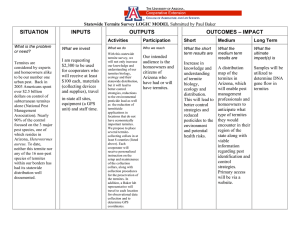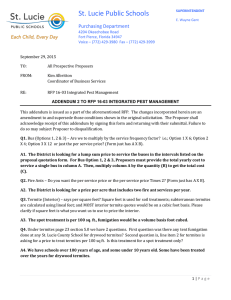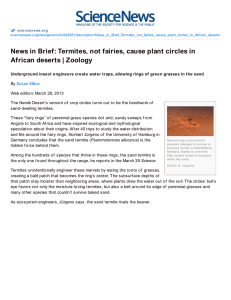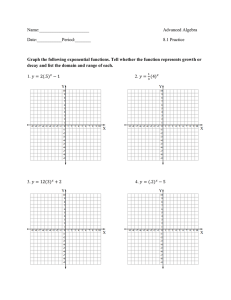4)^ Ornamental Grasses PLANT PROFILE- Cochise County Master Gardener
advertisement
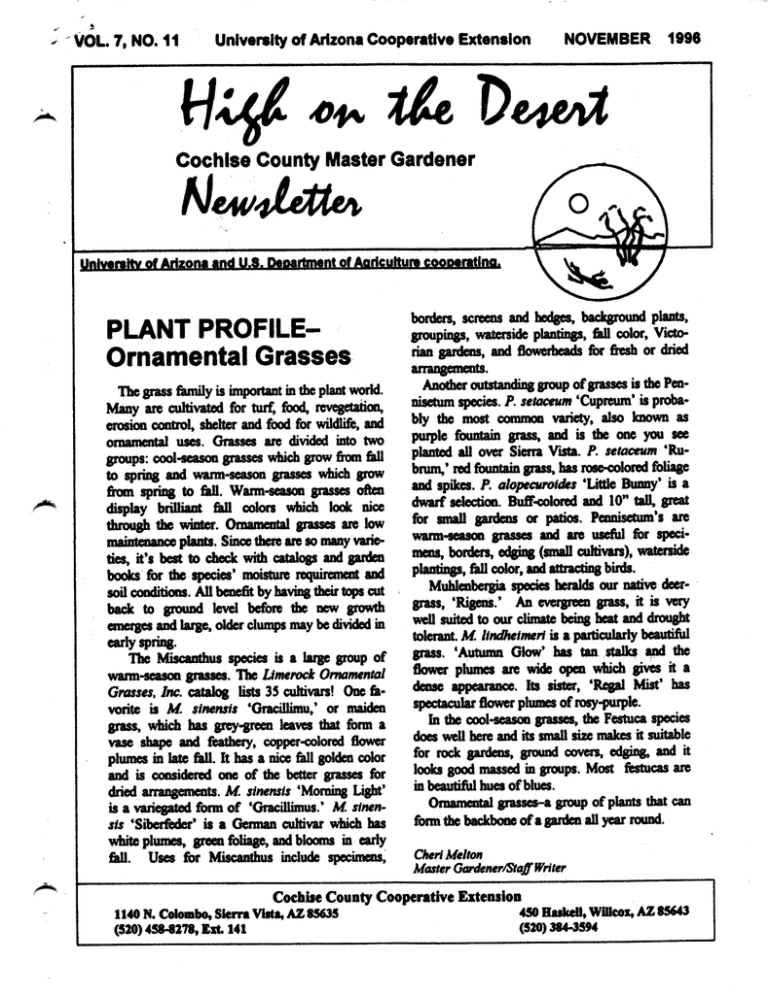
VOL. 7, NO. 11 University of ArizonaCooperative Extension NOVEiMBER 1996 4)^ Cochise County Master Gardener PLANT PROFILEOrnamental Grasses Tbegrass fimoily is inqxKtant inthe plaot worid. Mai^ are cultivated for turf, food, rev^etatioii, oosioa control, shelter and fM for wildlife, and onamental uses. Grasses are divided into two groups: cod^eason grasses whidi grow from fell to ^ling and warm-season grasses which grow from ^ring to fiU. Warm-season grasses often display brilliant fidl colors vdiidi look nice through the winter. Ornamental grasses are low maintenance plants. Since thoe areso many varie ties, it's best to diedt with catalogs and garden books fiv the species* moisture reqpiiremcat and s(^ conditions. All benefit by havingtheir tops cut bade to ground level before the new growth emogesand lat]^ dder clunq)s may bedivided in early q>ring. The Miscandnis q^eeies is a large group of warm-season grasses. The limrock Ornamental Grasses, Inc. catalog lists 35 cultivars! One fevorite is M. sinensis 'Oradllimu,' or maiden grass, whidi has grey-green leaves diat form a vase shape and feathery, copper-colored flower plumes in late fidl. It has a nice fidl golden cdor and is considered one of the better grasses for dried arrangements. M. sinensis 'Morning Light' is a vari^ated frxm of 'Cracillimus.' M. sinen sis 'Siberfoder' is a German cultivar which has bmdns, screos and het^es, background plants, ^oupmgs, waterskfe fdantings, fidl cdm, Victo rian gardens, and flowmheads fix fresh ae dried arrangements. Anodier outstanding group ofgrasses is die Pen- nisetum species. P. setaceum 'Cupreum* is prdiably the most common variety, also known as purple fixmtain grass, and is die one you see planted all over Siena >^sta. P. setaceum 'Rubrum,' redfountain grass, hasrose-colored foliage and spikes. P. alopecuroides 'Little Bumty* is a dwarf sdectioo. Buff-colmed and 10" tall, great fiiv small or patios. Pennisetum's are warm-season grasses ate usefid for specimeas, borders, edging (small cultivars), waterside plant^, fidl C(^,and attracting birds. Muhlenbergja qiedes heralds our native deergrass, 'Rigens.* An evergreen grass, it is very wdl suited to our dimate being heat and drought tolerant. M. lindheimeri is a particularly beautiful grass. 'Autumn Glow' has tan stalks apd die flower plumes are wide open wfaidi gives it a dense appearance. Its sister, 'R^al Mist* has spectacular flower plumes of rosy-purple. hi the cod-season grasses, die Festuca iqiecies does well here and its small size makes it suitable for rock ^tfdens, ground covers, edging, and it lodes good massed in groups. Most fintucas are in beautifid hues ofblues. Ornamental grasses-a group of plants that can fixmdie badcbone trf'agarden all year round. white plumes, green fidiage, andblooms in eariy fidl. Uses fiv Miscanthus indude specimens. Omri Melton Master Gar^ner^affWriter Cochise County Cooperative Extension 1140 N. Coh»ibo,SleiTa Yista. AZ8S63S (520) 458-8278, Ext 141 450 HaskcU,WOicox, AZ 85643 (520)384-3594 > Cuttings er's Club will meet Novanber 21 at the Mem Bishop Ro(»n of the Sierra Vista Library. VirginiaDennisou will present the program "Spices ofthe Southwest." 'N' Clippings > The Sierra Vista Area Garden Interested in the Arizona Tree Seedling Pipgram for 1997?Appli cation forms are available at the Sierra Vista Cooperative Extension Office. Greraiwood Nursery of > The Butterball Turkey Co. will have a turkey hot line available to offer you assistance weekdays fiom 7 am - 7 pm Nov. 1 to 27 and Thanksgiviiig Day fi:om 5 am - 5 pm. The number is 1-800-323-4848. You amtact > Watch for details on the High Desert Gardening & Landsc^ing Ccmforaice coming up cm February 13-15, 1997! them by can even e-mail htQ)://www.butterb^.com. at McMinnville, TN offers a wide va riety of shrubs, trees, and ground cover bareroot seedlings at a very reasonable cost. All seedlings grown for the program are grown in Arizona, Colorado, and Montana. > Rod^ts have been found to be one ofthe most coimmm carriers of A Favorite Vine the hantavirus, which has caused the deaths of 67 people living in the There are many beautiful vinesthat willgrow and flower in United States since 1993. Follow our climate: some are amnials, these precautions to help protect you and your family. 1. Never sweep or vacuum dry mouse dnq>pings which could dis perse virus-lad^ dust into the air. some perennials, some lose flieir 2. Never toudi a dead mouse with your bare hands. 3. Avoid practices that mi^t at tract mice by keeping all food and garbage in covered containers. 4. Take steps to keep rodentsout of your home. 5. Control the rodent populations outside. Newsletter Staff: Carolyn Gruenhagen Barbara Kishbaugh Cheri Melton Virginia Wes4>lial leaves in winter, and stxne remain evogreoi. Here's an idea for a nice ever green vine to grow on a trellis, fence or lattice and it is (»ie that has (fone well for to&-Jasmm polyanthum. One of the comnKni Page 2 It's hard to decide wbat is the best feature of J. polyarUhum, sinceit stays greenflie year around and in April (in Sierra Vista) it covers itself with clusters of blocxns that ate pink in bud and \ichite upcHi opening. They are sweetly fi'agrant, and will perfume a largearea such as flie whole patio when planted nearby. Humming eral other types of true Jasmines, as well as some plants fliat aren't Jasmine at all. year 'round residents-mostly Black but fliat name is also used for sev It is available in manyplacesin the localarea. J. polyanthum is flist growing to about 20 feet tall. It will get over 10 feet tall in just a year or so from planting if it is happy. Minegrows on the North side of my house (m a lattice attached to the back patio. It can take full sun, but in our hot after flowering and just like Jack's Horticulture gettingtoo heavy for its siq)port. birds seotn attracted by the flowers, and even though they bloom here so early (before many of the hum mingbirds have returned fixnn their winter homes) we do have some names for it is "winter jasmine," summers 1 fliink it does be^r with a little aftemocm shade. Prune it Robert E. Call, Extension Agent, It is a "light weight" vine, which can climb on lattice woik without beanstalk, it will climb right back up in no time. Chinned Hummingbirds. 1 keep two small feelers up for them in winter, and then when sprirtg ar rives and more birds return, 1 put up the larger feeders in addition to the small cmes. This year we had a hununingbird nest in the tangle of our J. Polyanthum vine, and we could watch developments from the kitdi^ window. Maggi Crist Master Gardener How to Buffer the Wind Last mondi at the School ofHard Rocks I briefly discussed Codiise County wind. This month I want to offer further suggestions how to Orchards placed around your house will also break up the wind. Pecan trees grow successfully in our area and are relatively easy to plant and maintain. If you purchase a three or four year old tree, har vesting nuts in two years is possi ble and likely. In Cochise County we have pre vailing southerly winds in the sum and color. Native plants can also be used to inhibit tiie force ofthe wind. Agave are formidable barriers when ma ture and there is nothing more southwestern disperse the wind around the trunk and through flie branches and and should be planted as soon as the well is in and water available. When placing y(»ir windbreak, three or more plants staggeredin heightwill force the wind upwards and away fiom structures. They also add privacy and act as a dust barrier along a country road. Evergreen trees-Arizona cypress, Aleppo pine, junipers and oak trees are a good selection. Evergreen trees are preferred as they remain full and will bow with the wind without breaking limbs. These trees may reach twenty feet high in about ten years if a drip system is installed with a steady water sup ply. Hie Heritage oak is a feirly good grower, also. Cottonwood, elm, and eucalyptus trees can also be used, but thty are not recommoided for placement near tte house. Winds can easily snap limbs causing them to fell onto the roof. than an ocotUlo fence. The wind passes betweenthe upright ocotillo limbs diminishing cause the trees act as buffers and Wh«i planning a homesite, trees Around the house vinmg plants make great wind buffers. Grapes grow well in Codiise County, giv ing shade in tiie summer with tiie secluded area filled with fragrance will hear the wind whistling around and see the wind shaldi^ the boughs of the trees. But the wind will not push you to the ground be K act as buffers snake hideout. around a porch create a semi- mer aid some strong northerly stonn winds in the winter. If you are in a forest on a windyday, you our homes. or patii is not recmmnaided since the dense growth is a cool summ^ added bonus of fhiit. Passion vine, catolaw vine, and honeysuckles confuse the wind. l^ves/needles. We can use this same idea to buffer winds around wind. Placing them near tiie house the force. Oleanders are wcmderful soutiiem Arizona plants and will make terri fic windbreaks and a great habitat for desert creatures. They are fest growing, bushy and full, eve/greoi, Barbara Kishbaugh Master Gardener^taffWriter and flower at an almost constant rate. It is a lovely plant, but re member the leaves and seeds are poisonous. (See High on the De sert Newsletter, August 1996, Page 3) Desert hackberry and pcnnegranate are perfect as windbreaks and also for the bird lovers. They have multiple smaU branches to protect the anall nests. Pyracantha is used extensibly in the urban setting and is a good evergreai selecticm. The red berries provide winter food for native bird species. Pyracantha can be trained as an espalier plant, a hedge, or even to look like a tree. Many other evergreoi hedges can also be used as mediumgrowth pe rimeter plants. Clumps of fountain or other decorative grasses between the Jioyttmbu* JLymmbm J This is a good time to install a drip system. y Replace summer mulch with fresh mulch. y Start a winterherb garden, y Protectplants fixim fi'ost. (The Coqierative Extension Offlce offers a bulletin Frost and Frost Protection. Call for a copy.) house and the initial windbreak will further disburse the force of the Page 3 The Agent's Observations This month Dr. Robert Smith, Department of Entomology, Uni versity of Arizona, answers ques tions about pest control services in Arizona. Question: What is a pretreatment? Answer: A pretreatment consists of a chemical treatment (with an EPA registered termiticide) of soil to form a barrier against subterra nean termites invading a structure. A termite pretreatment is an impor tant part of any structure built in Arizona. Question: How do ch^cal barri ers work? Answer: Chemical barriers work by repealing/killmg termites that contact the treated soil. Question: Does pretreatment pro tect against all kinds of pest termites? Answer: No. Pretreatments do not protect structures against drywood termites. used for pretreatmrait? Answer: There are several includ ing a new penetrating boric acid spray. protectmg Arizona structures. Absolutely not! The measures of the qut^ty of a ter miticides are how effective it is in excluding termites, and how long it lasts. In Arizona chlorpyrifos per forms well initially but looses its rate. Question: Do all termiticides have the same performance in all parts ofthe county? Answer: No. Every r^on has its best and worst performers and they differ fiom locality to locality. Question: Why does chlorpyrifos perform so poorly in Arizcma? Answer: It is not known for cer tain, but the poor showirig proba bly has something to (k> with our Question: Why do pretreatments fiul within months or a few years very high t^peratures and our dry, alkaline soils. after construction? Answer: Pretreatment fiiilures re Question: Are termiticides harmful to people? sult fimn poor coordination be tween rq>plicator and building (xmtractor and or poor pretreat ment design whidi may involve se Answer: All pesticides are poten tially injurious to humans, pets, and odrernootaigetorganisms. Ob serve all label instructions. EPA registered termiti- cides are pre sumed to be safe for use in accor dance widi label instruction. Question: Are pretreatments al ways effective in excluding Answer: Property applied and well-designed pretreatments can be e:q)ectedto exclude termites fromstructures for many years. Question: Question: Do all EPA registered termiticides perform equally well in termiticide at the high^ labeled years. termites? Question:What are the chemicals Answer: effectiveness r^idly. Permethrin, on the odierhand, is very persistent in Arizcxia, lasting longer than IS What constitutes a properly applied and well designed pretreatment in Arizona? Answer: A first-rate pretreatment requires cooperation between the applicator and the building con tractor. In selecting the best ter miticide for Arizona, use a 1% active ingredient (A.I.) concrartration and foe applicatimi of foe lection of a termitici^ that does not hold up well in Arizona, using low ccmcentration of active ingiedioit (A.I.), incomplete coverage of the soil, or use of an inadequate volumeof finishedspray. Question: Is someone at foult if a pretreatment foils to exclude termites? Answer: Absolutely! If your new house has a leaky roof, isn't there somerme at foult and responsible to fix it? Question: Is there a pr^reatment for drywood termites? Answer: Y^, in a manner of speaking. Well maintained painted wood carmot be infested by drywood termites. Also, foe treatment ofimpainted wood of any kind with a borate product such as Tim-bor® or Boracare® will render the wood (Continued on next page) bsued in ftirthmnw ofCooperative Extension work, acts ofMay 8and June 30,1914, in coopmtion with tbe United States Department ofAgriculture, James A. Christens^^^ Dire^,Cooperative Extoision, College nfAgriculliite, The Ihdveisity ofi^rizona and Arizona Cotmtiea coopmting. The Uaiveinty ofArizona Coll^ofAgriculture is a equal 0|^)^uiiity ^pioy^ au^cttiz^ toprovide r^iearch, educational informatifxi and other service only toindividuals and institutions that functicm vddiout regard to sex, race, religion, color, national carigin, age, Vietnam Era Veteran's status, ordisability. The information givai herein is suf^lied with the understanding that no diserimination is intended and no endorsement hy Coqierative Extension isimplied. Any products, services, woi^nizations that are n^itioned, shown, orindtrecUy implied in this publication do not inqily etidorsem^ by the University ofArizona. Page 4 unin&stable by termites of any kind so Icmg as the wood is kept dry aiter treatment. getting a lot for his money. Fumi gation is in feet a low overhead, extranely high profit operation. treeis sigrudledto cease productitHi of chl(H'(q)lQ'll. Wife nogreen bdng Question: What is the txeatment That's why the pest (xnitrd indus try likes it. have been pres^ in the leaf all along finally ccnne out. The colors are caused by sugars that are for a structure infested with subterraiffian termites? Answer: Remedial treatment for subterranean termites enq>I(^s the same chemical termiticide that are Question: How does tire pest con trol (^ator know where to spot treat for drywood termites? Answer: Drywood termites always added to the lea^ other c(dors that stored in the leaf. They change color whra exposed to sunlight. The best c(Hiditi(His for brilliant autunm colors are dry summers used for pretreatment, but the ter miticide must be a|>plied using techiques that require special equipment. Essentially, ten^dial produce sculptured pellet fiass which tiiey dispose of fiom so called holes" in the infested wood. The telltale accumulations followed by early autumn rains. The fell nights should be cold but not fieezing. Wet weather in late treatmoit attonpts to renew a bro- of drywood termite fiass will show aiitiimii kills the colcH*. Trees grow k«a chemical soil barrier. Some of the homeowner where drywood ter mites are wotidng and vhere the wood must be drilled and injected wife termiticide. No fiass, no dry- the retro-treatment techiques are subslab injection, rodding, trench ing,treating, and backfilling. wood termites! Question: What is the treatment for a structural infestation of dry- ing near streetlights keep their leaves Irniger than other trees, be causeit is the letigfe of the daythat triggers the charigo-not the t«nperature. Question: How do I find a reliable wood termites? Answer: Usually drilling the in fested wood and injecting it witii a Answer: Ask your firi^ids and termiticide is a reliable and eco- Arizcma Structural Pest Control neighbors. Also, you may call fee nomical treatment finr drywood Board and ask for fee conq>laint re termites. cord for any licoised pest control c(mq>any in Arizona. Finally, get proposals and bids fixxn several conqranies to do fee needed work. Ask questions about the proposed procedures andfees. Compare! Question: I have a drywood ter mite infestation and my pest con trol company says I need to have my house t^ted and fiunigated. procedure is very expensive, isitr^ly necessary? We will ccmclude this four-part series (hi termites next month wife Answer: No! Tenting and fiunigation for the drywood termites that a discussi(Hi of wcxxl infestaticm re occur in Arizmia is almost never ports disclosure andbuying a hcnne necessary nor is it especially effec tive. Spot treatment is tiie effective in Arizona. and economical treatment for our drywood termites. Question: If tenting is not really necessary and not especially effec tive vtiiydo pest control companies recommend the procedure? Answer: Profit and marketirig, pure and simple. Tenting and fiuni- ^ gation is a spectacularly showy pest control procedure tiiat gives the consumer the impression he is Robert E. Call ExtensionAgent, Horticulture The Virtual GardenerGardening In Cyberspace There is a wealth of informaticHr on gardening (m fee World Wide Web. You can learn how to t^ into fee gardening expertise avail able fiee fixnn university reseanfe centers, fee Cooperative Extension Service, and world class gardeners wife your Wd) browser. I will be teaching a class on GardKiing in Cyberspace at Codiise Coll^e, Si erra Vista Campus on Saturday, Dec. 7 from 10:00 am until nocm. Dvond hwifbuoui ccmm jfom tk9 La$iH ikai m9aHi He faU «/// Why do leaves turn colors in the fall? In the summer, fee leaves (xm- stantly replace fee green chloro phyll. When the days shorten, fee For informaticHi or registraticm, contact Codiise College, N<hiCredit Program, 901 N. Colombo Ave., Sierra Vista, AZ 85635 or caU 515-5496. GaryA. Gruenhagen Master Gardener Pages BULK RATE POSTAGE & FEES PAID USDA PERMIT No. G268 COOPERATIVE EXTENSION U.S. DEPARTMENT OF AGRICULTURE THE UNIVERSITY OF ARIZONA TUCSON, ARIZONA 85721 OFFICIAL BUSINESS PENALTY FOR PRIVATE USE $300 JOHNSONGRASS (the "Wicked Weed") GRASS FAMILY-Gramineae JOHNSONGRASS- Sorghum halepense (L.) Pers. Johnsongrass is usually considered by many stockmen to be a good feed for their animals. It is a "good" feed source as long as the leaves do not produce a Q^de type of poison known as hydrocyanic (prussic) acid and then the grass becomes ^ctremely deadly for all livestock. What causes Johnsongrass to be come poisonous? It spears that any thing viiich influences normal plant growth may trigger the release of HCN within the plant: rapid leaf growth, or wilting caused by trauma in the form of trampling, freezing, dryness, or even the cutting of the plant. How do you know whena plant has been traumatized and may be produc ing HCN? One doesn't know and stock are ^t to be poisoned by John songrass at any time. Acute poisooing results in death fixnn respiratory feilure following the first appearance of symptoms within a few hours; r^id and complete recovery may occur af ter a sub-lethal dosage (even after se vere poisoning). Breathing is, at first, deep, becoming r^id and labored, fi nally resulting in noisy, violent gasp ing, then trembling, staggering, and convulsions; bloat is cmimrm in the late stages of poisoning. This grass is a prohibited, noxious weed in Arizona and total eradication is almost irtqiossible, dueto its lengdiy underground strans, rhizomes (up to 2 Yz feet deep), aiul dormant seeds. An attractive leafy perennial, its height may reach between threeto sewen feet in height, and its blades may be two feet IcHig and 1/4 to 3/4 inches in Iraigth. The plant's flowermg tqis may be as much as two feet long and produce dark, reddish-brown grains. It flowers from April to November and prefers to grow in irrigation ditches and in cultivated fields. It is found in elevations up to 6,000 feet. Peggy Dierking Master Gardener [Poaceae. The grass femily is un- ^ubtedly the most important plant family in terms of usefiilness to hu mans. All the world's important grain crops are grasses; the baniboos (giant grasses) are useful in building and crafts. Many grasses are used in lawns or as omamoital annual or per ennial plants. Some botanists usei Gramineae as the femily name grasses.] Sunset Western Garden Book, 1995
